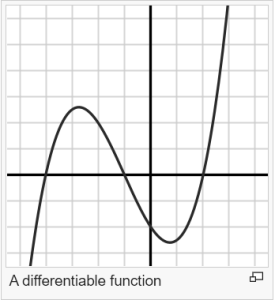Equations related to differentiability
- Derivation of sin x: (sin x)’ = cos x
- Derivative of cos x: (cos x)’ = -sin x
- Derivative of tan x: (tan x)’ = sec2 x
- Derivative of cot x: (cot x)’ = -cosec2 x
- Derivative of sec x: (sec x)’ = sec x.tan x
- Derivative of cosec x: (cosec x)’ = -cosec x.cot x
- Derivative of xn: (xn)’ = nxn-1
- Derivative of ex: (ex)’ = ex
- Derivative of ln x: (ln x)’ = 1/x
It is very common to associate the meaning of a function that is differentiable with a variable as we are not clear along with any point at the graph when exactly a function can be differentiated. So comparing a differentiating function with a variable is not wrong altogether if we go through the concept properly.

Concept of Differentiability
A function is said to be differentiable or we can say that the differentiability of a function only exists when it has a derivative for all the values of its domain. In layman language, if the graph can be plotted in a particular way to properly explain the way that function works for its domain then only we can say the function is differentiable in a sense.
There are many conditions for a function to be differentiable but we will move on to that later. So first let us start with the differentiability of a real function that operates in a single function only. If we want to get very deep into this concept then we should also consider the concept of limits as every differentiable function has to be substituted with a value at some step or the other and for that to happen, the concept of limits should be at our fingertips.
The catch in this concept is that the variable in every case which is the alphabet,x, itself always tends to zero. If this is not the case then first we have to derive the question in such a way that we reach this conclusion and then proceed further with the question part.
Differentiation of a single variable function
In this concept, firstly we assume that there is a function that exists and the only condition is that this function should always be a real number. This is the first and the foremost method to test the differentiability of a function. Nothing apart from this integer is acceptable. Then let us assume that there is a variable which is usually termed to be the alphabet h.
There is a very simple formula for this type of question and that formula is firstly we take the limit and take the variable h tending to zero. After that, we create a function that is made by the addition of both the variable and the function that was there previously and after that, we subtract it by the original function. So the part that is left is only the new variable or has it is mentioned above.
After this operation, we divide the function by a term given in every question. If this experiment is done and we get an integer answer, that means the function is continuous at the original variable and the differentiability of the function is proved.
Classes of differentiability
Now, this is one of the most interesting topics to discuss in differentiability as there are some functions that even after having a graph that can break in its domain are still continuous. Now, these are some special functions and this type of discontinuity is referred to as the jump discontinuity.
Now, most of the functions that fall under this category are trigonometric functions or some functions that involve greek variables like epsilon, alpha, and beta. Now let us take an example of a differentiable function that is differentiable when the value of the variable is zero and not differentiable when we put any other value in it apart from zero. These are the functions that fall under different classes in differentiability of function.
![]()
Special cases of differentiability
The information given above is enough to understand the concept of differentiability. Now as we move further let us understand some cases of differentiability of a function that is rare to occur. The above formula of the differentiability of a function that we discussed in the article was for a normal case but when we discuss the case of functions of higher-order for differentiability then we introduce another term that is usually represented by j and which stands for linear map.
Now, usually, the concept of the linear map does not interfere much with the normal ways by which we do differentiability but still, to give some information about this, we can say that the linear map or j is not a number but instead, it is a Jacobian matrix and if this matrix is to be used then it has to be differentiable at all points across the domain of the original variable. The interesting fact while dealing with higher-order cases of differentiability is that the whole equation has to be equated with zero as usually one of those variables is missing and we have to find them.
Conditions for differentiability to exist

There are only one to two conditions that are important and have to be kept in mind for any function while checking its differentiability. The first and most important condition is that the limit to which the function is tending should always equal the slope of that function along with the graph. The second condition is that the function should be continuous along with its derivative.
Conclusion
The concept of the differentiability of a function is one of the most interesting topics in the calculus part and important too, without checking this we can never be sure of the existence of the function in the first place.
 Profile
Profile Settings
Settings Refer your friends
Refer your friends Sign out
Sign out






